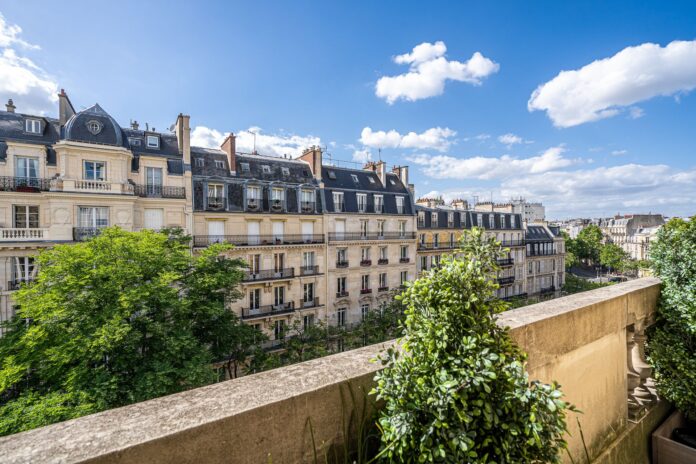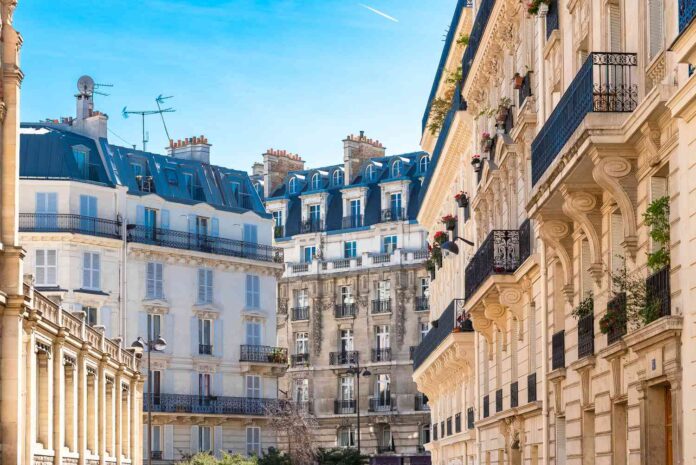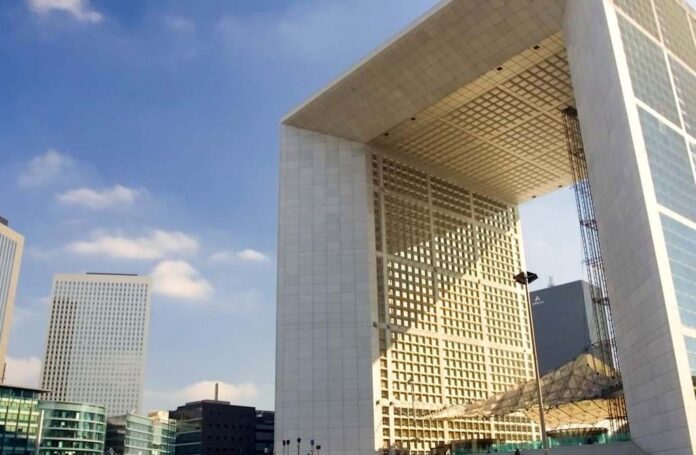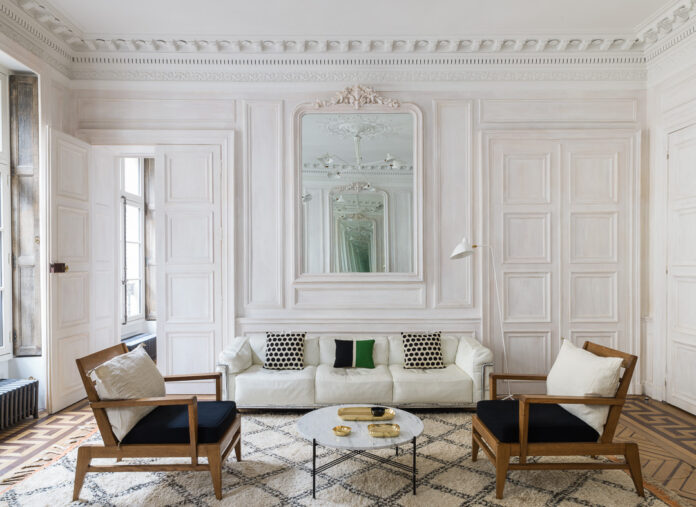
Paris, the city of lights, carries an architectural heritage as diverse as it is elegant. The cityscape presents a rich tapestry of styles, spanning centuries and encompassing everything from classic Haussmannian grandeur to cutting-edge modern designs. Join us on a journey through the evolution of Parisian home styles and uncover the layers that make up the city’s architectural allure.
Haussmannian Architecture

The heart of Paris is undeniably Haussmannian. In the mid-19th century, Baron Georges-Eugène Haussmann, tasked with modernizing Paris, implemented a large-scale urban redevelopment program. The result was a city transformed with wide boulevards, uniform sandstone facades, and characteristic wrought-iron balconies. Haussmann’s vision introduced buildings of uniform height and design, featuring large, symmetrically arranged windows and intricate stone ornamentation.
The interiors of Haussmannian homes were as grand as their facades, with high ceilings, herringbone wooden floors, and ornate moldings. This architectural style has become synonymous with Parisian elegance, and today, Haussmannian buildings are sought-after residences, embodying the quintessential Parisian aesthetic.
Belle Époque Elegance

The Belle Époque era, which translates to ‘Beautiful Age,’ was a period of peace, prosperity, and progress between 1871 and 1914. Parisian architecture during this period, including exquisite apartments for sale in Paris, mirrored the optimistic spirit of the times. Buildings from this era are known for their ornate details, intricate moldings, lavish interiors, and a strong sense of symmetry.
Many homes, including at least one apartment for sale Paris, feature Juliet balconies, stained glass windows, and highly decorated entrance halls. The Belle Époque was also a time of technological advancement, with the introduction of elevators in buildings and the use of steel and iron in construction, seen in the famous Eiffel Tower.
Art Nouveau Charm
Following the Belle Époque, the Art Nouveau movement swept through Paris at the turn of the 20th century. This movement was characterized by its rejection of historical styles and its embrace of the natural world. Parisian homes in this style are distinguished by their organic shapes, decorative motifs inspired by plants and flowers, and innovative use of materials like glass and wrought iron.
Buildings from this period often feature intricate ironwork, curved glass windows, and ornate tilework. Notable examples of Art Nouveau architecture in Paris include the famous Castel Béranger and the remarkable Lavirotte Building.
Modernist Architecture
In the early 20th century, modernist architecture began to take hold in Paris. This movement was defined by a functionalist approach, minimalist aesthetics, and innovative construction techniques. The advent of new materials like concrete, steel, and glass allowed for unprecedented freedom in design and construction.
Modernist homes often feature open floor plans, large windows for natural light, and an emphasis on geometric shapes. This style represents a significant departure from the decorative styles of the previous eras. Iconic modernist buildings in Paris include Le Corbusier’s Villa La Roche and the Maison de Verre.
Post-War Rebuilding
After the devastation of World War II, Paris faced the massive task of rebuilding. This period saw the incorporation of new materials, techniques, and design philosophies. Homes from this era often feature practical layouts, simple facades, and an emphasis on functionality. This period also saw the introduction of high-rise residential buildings in the city’s outskirts, reflecting the need for mass housing in the post-war years.
Contemporary Designs

Today, Parisian architecture continues to evolve, with contemporary designs offering a fusion of modern and traditional elements. Current architectural trends prioritize sustainable design practices, integration with the surrounding environment, and the incorporation of international styles.
Innovative contemporary homes often feature energy-efficient designs, green spaces, and a blend of old and new. Notable examples include the Quai Branly Museum, which incorporates a vertical garden on its facade, and the striking glass and steel structures of the Louis Vuitton Foundation.
Eclectic Mix
Paris today is an eclectic mix of architectural styles, each bearing witness to different periods in the city’s history. From the medieval homes in the Marais district to the modernist gems in the 16th arrondissement, and the rentals St. Tropez, the city offers a unique blend of old and new.
The varied architectural landscape is a testament to Paris’s ability to respect its rich history while continually evolving and innovating. This fusion of styles gives the city its unique charm and character.
Preservation and Restoration
Preserving and restoring historic homes is a priority in Paris. While new construction and development are essential for a city’s growth, there is a strong emphasis on maintaining the architectural integrity of historic buildings.
Many old buildings have been carefully restored and adapted for modern living while retaining their historic charm. This balance between preservation and innovation is a key aspect of Paris’s architectural landscape.
Parisian Interior Design

Parisian interior design is renowned for its effortless elegance, blending classic and contemporary elements. From traditional Haussmannian apartments with their high ceilings and herringbone floors to modern lofts with minimalist aesthetics, the Parisian approach to interior design emphasizes refinement, quality materials, and a sense of individuality.
Hidden Gems
Paris is a city that never ceases to surprise, and beyond its well-known architectural landmarks, it is brimming with hidden gems tucked away in lesser-known neighborhoods. These enclaves unveil a rich tapestry of architectural styles that may not be immediately apparent to the casual visitor.
One such neighborhood is Butte-aux-Cailles, renowned for its picturesque streets adorned with art nouveau-inspired homes. Strolling through this charming district, one can’t help but be captivated by the intricate ironwork, whimsical details, and flowing lines that epitomize the art nouveau movement. Each building tells a story, showcasing the creativity and craftsmanship of the era.
Another hidden gem is La Campagne à Paris, a tucked-away oasis that evokes a village-like atmosphere within the bustling city. This unique neighborhood boasts a collection of detached houses with their own gardens, offering a respite from the urban landscape.
The architectural styles found in La Campagne à Paris span from charming cottages to elegant townhouses, each exuding its own distinct character. As you meander through its narrow lanes, you are transported to a different era, where the pace slows down and the ambiance feels timeless.
These lesser-known neighborhoods in Paris provide an opportunity to go beyond the well-trodden paths and uncover the city’s architectural diversity. They offer a glimpse into the lesser-explored facets of Parisian architecture, where hidden treasures await those willing to venture off the beaten track.
Exploring these areas allows you to appreciate the ingenuity, creativity, and history that have shaped Paris into the architectural marvel it is today. Whether you are an architecture enthusiast or simply curious to discover the city’s hidden corners, these hidden gems hold the promise of delightful surprises and a deeper understanding of Paris’ architectural heritage
Conclusion
From Haussmannian grandeur to contemporary innovation, Parisian home styles are as diverse as they are captivating. The city’s architectural heritage, a testament to its rich history and cultural evolution, continues to charm and inspire. Whether through the elegance of a Belle Époque residence or the bold forms of a modernist building, Paris remains an enduring symbol of architectural brilliance.



